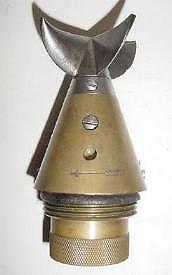

The spar torpedo required the two vessels to be in extremely close proximity which posed considerable danger to the attacking vessel. To overcome this problem, British Engineer Robert Whitehead developed the self-propelled torpedo in 1866. Most navies of the world took great interest in the new weapon, however, the United States Navy did not.
When the U.S. Navy commissioned its first torpedo boat almost twenty-five years later, in 1890, the other navies of the world already had nearly one thousand of the vessels in operation. Over nine hundred were in use among the five major navies of the world alone.
In 1891, during the Chilean Civil War, the Chilean naval vessel ALMIRANTE LYNCH torpedoed and sank the rebel Chilean armored vessel BLANCO ENCALADA with a 14 inch Whitehead torpedo at the close range of one hundred yards. The world, including the U.S., took notice, in spite of the impractically and unusually close range.
In 1896, the Austrian naval officer Ludwig Obry invented the gyroscope, making the torpedo a reliably stable weapon.
The torpedo was a new, highly feared weapon system which saw very
little use during the war. In spite of all of the amazing claims of its
abilities, the Spanish American War saw no vessel on either side was
sunk through the use of a torpedo by the enemy. However, at the battle
of Santiago, the Spanish cruiser VIZCAYA
apparently suffered a hit to a loaded torpedo tube in it bow, blowing
out the bow, and putting the ship out of action.

The torpedo warhead, usually consisting of gun cotton (H above) was fired by a plunger, which, when it contacts an enemy vessel, pushes inward and contacts a percussion cap. The air flask (B above), which contained air under as much as 2,000 pounds per square inch, contained air used to run the compressed air engine (D, above). The torpedo was equipped with dual propellers, running in opposite directions, to avoid any veering of the torpedo from the torque of the propeller
The launching mechanisms used for torpedoes aboard torpedo boats, as well as on larger vessels such as the USS OLYMPIA and USS OREGON were not generally directional. With some exceptions, the launchers used, had to aimed by aiming the entire vessel within certain operational limits. Otherwise, the vessel basically had to wait for the enemy to cross into its line of fire. For this reason, the USS OLYMPIA carried six torpedo tubes in various locations. Some torpedo boats carried some trainable launchers. The torpedoes themselves had no instrumentation that would allow them to home in on an enemy ship.
The torpedo, however, did have two advantages. First, had a torpedo
actually hit its target, its charge would have created great damage.
Secondly, and more importantly, was the threat the weapon created.
Though the torpedo did not inflict any major damage during the war, the
sheer threat of its existence was a weapon in itself. Even large armored
vessels had to be ever vigilant to prevent night attacks by torpedo
boats and their deadly torpedoes, creating an additional strain on the
ships' crews. The torpedo required the development of counter-measures,
caused an alteration of tactics, and was useful as a weapon of terror.
Both sides in the Spanish American War were equipped with torpedoes, and
the Spanish torpedo boats were one of the most feared wings of the
Spanish Navy.

| Length: | 11 feet | |
|---|---|---|
| Diameter: | 18 inches | |
| Weight: | 836 pounds | |
| Speed: | 26 knots | |
| Maximum Range: | 1000 yards | |
| Charge: | 110 pounds | |
| Explosive: | Guncotton | |
| Motive Power: | Three cylinder engine, driven by compressed air. | |
| The torpedo was launched by a small powder charge. |
(As a service to our readers, clicking on title in red will take you to that book on Amazon.com)
Alden, Cmdr. John D., USN (Ret.), American Steel Navy , (Annapolis: United States Naval Institute Press, 1972).Alden, John D., Cmdr., USN, (Ret.), American Steel Navy. (Annapolis: Naval Institute Press, 1972).
Clerk of Joint Comittee on Printing, The Abridgement of Message from the President of the United States to the Two Houses of Congress. (Washington: Government Printing Office, 1899). 4 vols.
Etchepare, Francisco Javier Pérez, Santiago, Chile (correspondence with author concerning the ALMIRANTE LYNCH.
Harris, Lt. Cmdr. Brayton, The Age of the Battleship. (New York: Franklin Watts, Inc., 1965).
Howser, Doug (image of torpedo pistol)
International Correspondence Schools, The Mariner's Handbook. (Scranton: International Textbook Co.1906) 224-228.
Naval History Department, Navy Department, Dictionary of American Naval Fighting Ships. (Washington DC: Government Printing Office, 1959).
Sternlicht, Sanford, McKinley's Bulldog, the Battleship Oregon . (Chicago: Nelson-Hall, Inc., 1977).